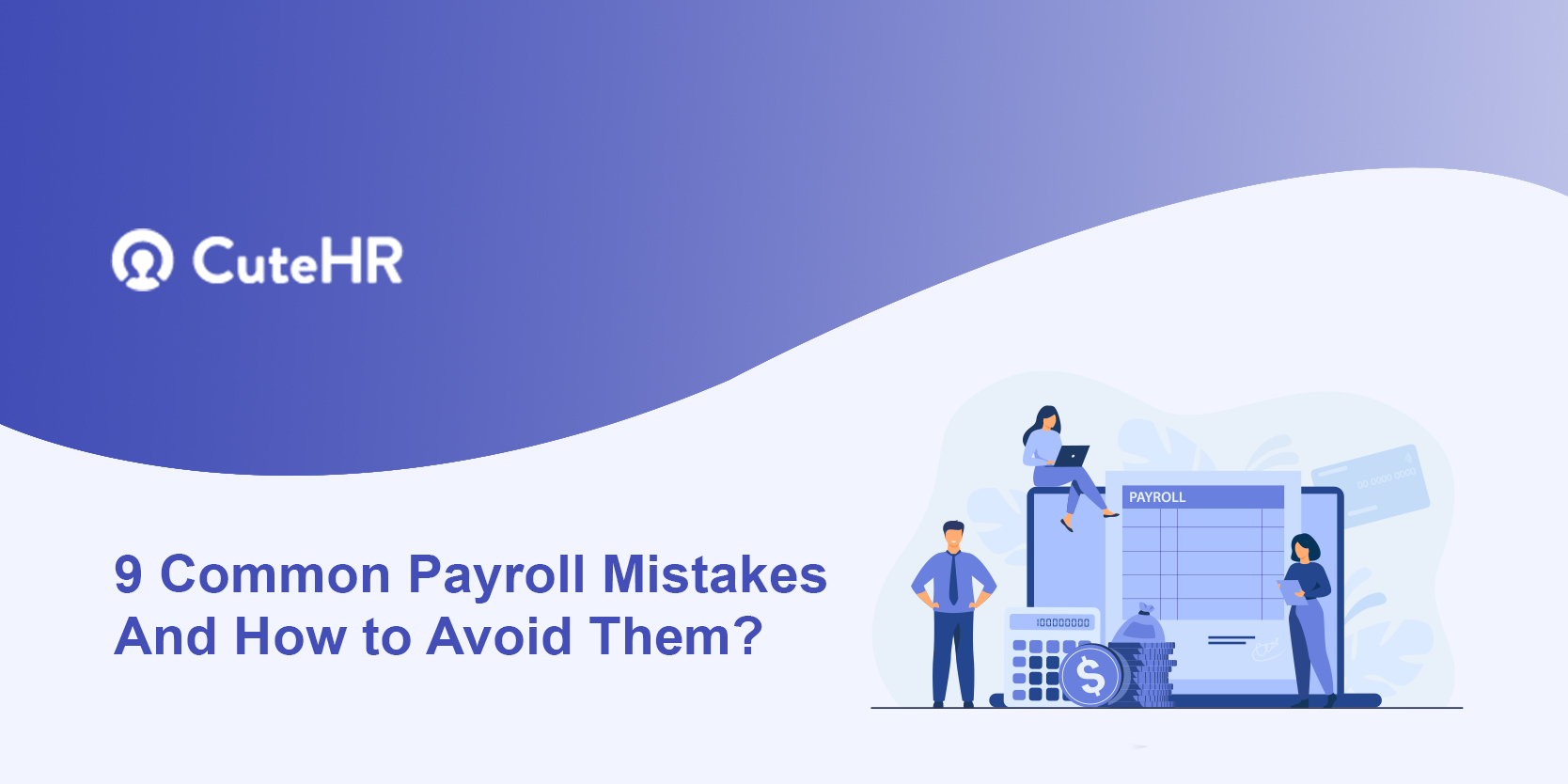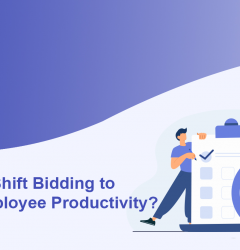10 Jun

Do you know? It is estimated that 82 million Americans – 54% of the workforce – face payroll problems.
When it comes to payroll, employers have a lot of duties. A complete payroll process includes making accurate and timely payments to employees, sending out tax forms by specific dates, paying taxes, and appropriately categorizing employees.
Payroll mistakes can have far-reaching ramifications. Small payroll mistakes may add up over time, resulting in strained relationships with employees, financial losses, and damage to the company’s good brand and reputation. In the worst-case situation, the IRS may become involved and charge fines against your organization.
Thankfully the payroll mistakes can be categorized into the following categories. Keep reading to learn about these payroll mistakes and how to avoid costly payroll mistakes.
Table of Contents
Top Payroll Mistakes People Make
As to say, there are a lot of payroll mistakes detected but what I am going to tell you in this article are the main one’s and they are as follows:-
1. Not Paying The Correct Amount
This may seem self-evident, but you’d be shocked how easy it may go wrong.
Always double-check that the payment amount was entered accurately into the payroll system and that the employee correctly recorded the hours.
It’s critical to double-check that all employee information, payment information, and tax withholding information are entered accurately into the payroll system from the start. Otherwise, there would be inaccuracies in every paycheck.
You must track and reimburse your employees’ overtime unless you are working with a contractor on a project basis. If you follow Section 59 of the Factories Act, you should be able to pay overtime at double the regular rate. You must keep track of and distribute employee payroll in accordance with all applicable regulations.
2. Unpaid payroll taxes
This can involve a wide range of federal, state, and municipal taxes however not all of them will be applicable to your company.
You must pay employment taxes on a regular basis as an employer. Employment taxes must be paid whether you hire full-time or part-time staff. To prevent fines, deduct TDS from workers’ paychecks every month and pay taxes on time.
However, while it appears to be simpler here, it is difficult to maintain. There are a variety of restrictions and rules that apply, so make sure to consult the official paperwork for such taxes to prevent making payroll mistakes.
3. Not Paying Or Paying Late
In the world of payroll, timing is crucial. But, with so many phases in the payroll process, it’s all too easy to miss a crucial date. Your employees rely on your firm to pay them regularly and on time; failing to adhere to a consistent schedule can erode employee confidence and negatively impact the company’s reputation. Not to add that several states have regulations for pay frequency.
Deadlines are just as crucial when it comes to payroll taxes. Late fines, penalties, and even legal difficulties may cost your firm a lot of money if you miss a tax deadline. Knowing your internal and external timelines—both for paydays and taxes—is critical to a seamless payroll process.
4. Identifying Employees vs. Contractors Incorrectly
Typically, small businesses hire independent contractors since their work is usually temporary.
It is a legal classification, not a personal choice, for a business owner to identify someone as an employee or a contractor.
Businesses must pay retroactive payroll taxes if they misclassify employees as independent contractors.
Because the number of temporary workers, consultants, and other independent contractors is increasing, it’s more important than ever to properly classify everyone who works for your firm so you can figure out how to submit payroll data for tax purposes.
5. Unpaid overtime
Apart from the fact that employees are irritated by this, which is understandable, it is also illegal not to pay them for overtime.
If an employee is considered nonexempt, he or she is entitled to 1.5 times his or her hourly compensation for any hours worked exceeding 40 in a workweek.
When calculating overtime compensation, there are specific criteria that must be followed, and payroll mistakes may be costly. Employees who were classed as “exempt” employees and so not entitled to overtime have been the subject of increased litigation in recent years.
6. Inability to maintain clean records
Failure to keep clear payroll records is one of the most costly payroll blunders you can make. The payroll department of your firm is in charge of establishing and keeping employee records. Maintaining a clean payroll benefits both your employees and your firm, as well as keeps your compliance with corporate standards.
HR managers, on the other hand, frequently fail to keep correct personnel records, resulting in turmoil and confusion in the workplace. The following are some of the most typical record-keeping payroll mistakes made by employers and HR managers:
- Not frequently updating employee data.
- Inadequacy of employee information owing to a lack of current employee data.
- Outsourcing payroll and supplying false employee information.
- Not preserving employee data for long enough (as per Government requirements).
7. Having an insufficient backup
Even if the person in charge of payroll is absent or sick, the IRS and the state, as well as employees waiting for paychecks, must get payments on time. There should be more than one individual who is competent in comprehending and managing payroll duties. Furthermore, if the computer goes down for any reason, you must have a manual backup mechanism in place to handle all payroll processes.
8. Neglecting or missing a garnish request
When a court orders an employer to withhold a specified amount from an employee’s salary, this is known as wage garnishment.
Instead, the funds are remitted to a person or entity owed money by the employee until the obligation is settled.
If you receive a garnishment request, file it as soon as possible. Also, make a note of it in your calendar, so you don’t forget.
9. Overly relying on the software program
For payroll, there are various fantastic systems programs, such as QuickBooks. However, the old saying “trash in, rubbish out” still holds true. Too many people fail to enter all of the necessary data or believe that the computer can do computations without all of the relevant information.
How to Avoid Payroll Mistakes?

Avoiding or eliminating each of the aforementioned errors requires a range of solutions, but we’ve provided our top recommendations here. By incorporating these factors into your payroll process, you may detect errors before they occur, making payroll faster, easier, and more accurate.
Payroll Mistakes #1. Learn Your Stuff
Many payroll mistakes occur as a result of payroll administrators not having enough or the right information. Laws and policies are always changing, and they can differ from state to state; it is critical for your payroll team to be up to date on current regulations for the state in which your firm is based (especially if you have a national or global presence).
Payroll mistakes can be avoided by conducting fundamental research (What is the difference between exempt and non-exempt employees?) and double-checking your assumptions (Is this person truly classified correctly?).
Payroll Mistakes #2. Choose the Right Tools
What is the most effective approach to prevent payroll errors from interrupting your business? Invest in payroll software and an HRIS that work well together. The correct HRIS will handle and update critical employee information such as wages, hours, account numbers, and withholdings and then transmit those changes to your payroll system, removing the need for double entry.
Simultaneously, the best payroll software should integrate with your HR system and automate the most time-consuming procedures. Payroll software makes it simple to run reports, submit taxes, and deliver pay stubs, among other things.
Payroll Mistakes #3. Maintain a Checklist
The tried-and-true checklist is always a safe bet. Payroll administrators have a lot to keep track of, even if they have software to help them. They can use a checklist to go through every stage of the procedure every time, inspecting each piece and ensuring everything is correct.
You should also retain a list of all new employees, all pay changes, all deduction changes, and other updates in one place, sorted by pay period. Then, while you’re working on the payroll for that time, you may go over each list to confirm that all of the adjustments were properly entered into your system.
Payroll Mistakes #4. Prepare reports prior to payroll
If you have payroll software, running a few essential reports before processing payroll can also assist you in discovering and preventing errors. We recommend running the following reports to ensure that all of your check amounts are correct:
- Deductions summary– This report summarises all deductions for each employee, allowing you to double-check the numbers.
- Payroll register– This report displays all payroll information in a consolidated format.
- Cash requirement– This report indicates how much money your company needs to pay payroll, broken down by category such as wages, taxes, deductions, and so on.
Consequences of Payroll Mistakes
Regardless of size, no organization is immune to payroll problems, and while the damage may be felt on the bottom line and organizations may be seen skirting the margins of the law in some cases, in most cases, the employee and business morale will be the hardest hurt.
Payroll might appear to be a daunting and confusing labyrinth. Fortunately, unlike the comparison, payroll comes with a road map, and specialists are ready to help organizations of all sizes avoid the most typical pitfalls.
1. Regular errors
Some of the most common payroll problems are inaccurate pro-rata pay for part-time employment, payslip reversals for payslip repair, erroneous application of tax instructions, and incorrect employee information. There is also the risk of misclassifying an employee, failing to keep adequate payroll records, failing to file taxes on time, and falling behind on payroll processing and output.
These challenges can arise regardless of the efficiency of the system in use or the person in charge of payroll. A technical breakdown may cause payroll delays, or the individual in charge may simply be too busy. Due to the lack of a dedicated payroll professional, the business owner may be forced to pay employees late.
This is frequently the case with smaller enterprises where entrepreneurs are on a low budget and must perform all responsibilities themselves. Employees rely on the money to pay their expenses and may be slapped with fines or left out of pocket as a result of the impact on the firm. This may have a severe impact on their relationship with the company, resulting in high personnel turnover and a bad reputation.
2. Breaks are prohibited
Unfortunately, holiday pay is one of the next most typical payroll issues. When a person quits the organization, this may be miscalculated, or payroll distribution and numbers may be impacted by public holidays, which cause automated systems to fail to process payslips and cause payment delays.
This has a significant impact on employee morale. Businesses must ensure that employees are paid the correct amount at the correct time and to the employee’s benefit. Employees who are aware of these problems are less likely to sue the company, so it’s essential to be prepared.
When it comes to payroll problems, the aforementioned is just the tip of the iceberg. Negative payslips, the inability to correctly repair errors, manual payment updates, overpayment amounts for medical aid, the impact of hours worked, time off, and employee-specific reductions are just a few of the issues that payroll faces each month.
Prevention is the Key
While payroll mistakes can occur, organizations can take steps to prevent many of these errors from occurring. Smaller businesses can benefit from hiring a payroll consultant to ensure that systems are correctly set up and easy to maintain while also providing much-needed confidence throughout the process.
While a payroll system may have been correctly designed at the time of installation, rules change, and the setup should be reviewed annually against current legislation.
Larger organizations should hire a professionally qualified payroll manager with a thorough understanding of payroll, including payroll accounting, payroll legislation, governance, and compliance, as well as extensive system expertise.
In addition, the payroll manager should have access to an income tax professional as well as a payroll consultant for assistance.
Must payroll errors be corrected immediately, or can the correction wait until the next payroll cycle?
The answer is likely to be determined by the state in which the person works and is paid. Employers are required by both state and federal regulations to pay employees for all earnings earned and due during the prescribed payment period. In many cases, state regulations provide more specific restrictions for the timeliness of wage payments.
Wages earned between the 1st and 15th of the month, for example, must be paid by the 26th of the month in California. Wages in other states must be paid within a specific number of days of the end of the pay period in which they were earned.
Despite employers’ best efforts, there are situations when hours worked are not counted in an employee’s pay for a variety of reasons. If the organization has created a payroll cycle of “paying current,” the risk of corrections increases. This payroll cycle entails predicting hours worked for the conclusion of the pay period so that payroll can be processed earlier in the pay week.
Some states have special rules for resolving an underpayment error. For example, Oregon enables employers to wait until the next pay period if the underpayment is less than 5% of the entire salary. For example, there is no state rule limiting the timing of wage payments or needed repairs in Florida.
In the absence of explicit statutory laws, it is critical for an employer to ensure that employees are paid on time for all wages earned. Employers should make payroll modifications quickly rather than waiting until the next pay period. Employers should also look into the reason for the payroll problem and make any required changes to avoid future wage payment errors.
Wrapping It Up
Payroll mistakes are common, but they are time-consuming. Because payroll mistakes sometimes go unreported, you are frequently ignorant of the harm done. As a result, the consequences of these errors accumulate gradually before shocking your company.
To avoid these problems, use the strategies outlined above to overcome frequent payroll mistakes. You might employ a payroll outsourcing partner to compute and distribute payments on a monthly basis. Remember to apply the aforementioned suggestions to locate the best service for your company.
Frequently Asked Questions (FAQs)
What are the risks in the payroll?
Businesses that run the payroll on their own, especially small businesses, are at a much higher risk of being disrupted by fraudulent activity and human error. When a corporation lacks the necessary internal controls to handle its payroll, it might face serious problems ranging from phantom employees to hour padding to buddy punching.
What is a payroll cycle?
A payroll cycle is the period of time that passes between paydays. It might be as little as a week or as much as a month. Several repeating steps occur throughout this time: Employees work and keep track of their time. The hourly wage is used to compute gross pay.












Himani